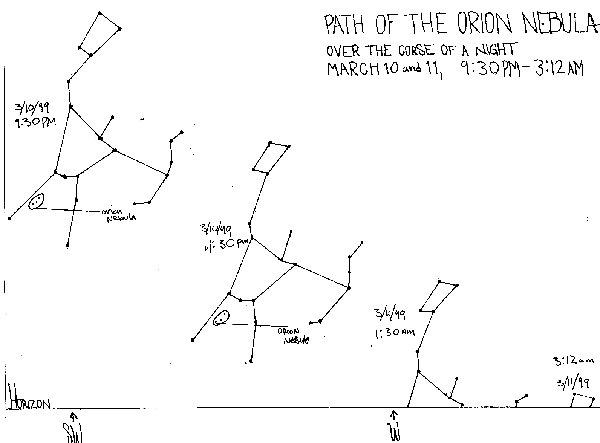When beginning this project we
were immediately faced with the problem of observing supernovae.
Since we could not observe a supernova, nor any supernova remnants, we
chose to observe the Orion Nebula being that it is a stellar nursery.
For our observations we used the following tools :10/50 binoculars, the
Orion telescope and the starry nights program to see the Orion nebula as
well as to track its path on the night of march 10th and is path across
the sky from march 10th to when it disappeared in may. There were
two main ways we observed the Orion Nebula. The first entailed looking
with our eyes through a telescope and binoculars and the second involved
using electronic resources to actually track the motion of the Orion Nebula.
We observed the Orion Nebula through
the month of march and april with our binoculars and the Orion telescope.
The Orion Nebula lies below Orions belt and to the naked eye is hardly
visible. The Orion Nebula, on a clear night, as observed with the
naked eye, tends to look like a very small fuzzy point of light.
With the magnification of 10/50 binoculars, the fuzzy dot becomes bigger
and brighter. We could make out three main points of light with a
white iridescent fuzz around the points of light. Although we were
not always able to see all of the constellation of Orion or the Nebula
every time we looked, the clearest of our observations with the binoculars
reveled the three main points of light and the haze around them.
When observing the Orion Nebula
through the Orion telescope we were able to see the Nebula with more magnification
and clarity. These observations revealed that there were many more
than three points of light surrounded by the white haze. However,
even with the Orion telescope the Nebula appeared fuzzy and it was difficult
to differentiate or approximate the stars from one another or how many
there were. We had far fewer opportunities to observe the Orion Nebula
through the telescope compared to with our binoculars, however, the observations
through the Orion telescope gave us a much better visual of the Orion nebula.
There were the three clear points of light surrounded by what appeared
to be thousands or even millions of little dots. Sadly, we never
observed the beautiful reds and pinks of the Orion Nebula with our own
eyes, but, we have been given the pleasure of some beautiful photos of
the colors.

(Orion Nebula, Photo credit: Jim Fullerton-Lake
Afton Public Observatory)
We also used the Starry Nights
program to track the path of the Orion Nebula across the sky as it traveled
by hour and by month. The first simulation we ran was of the motion
of Orion as it crossed the sky on the night of March 10th. We looked
at the change in position of the Nebula every two hours. We found
that it moved from south-west, where we started a 9:30pm, toward
the western horizon where it set at 3:12am. We found this helpful
in understanding the general nightly motion of The Orion Nebula in the
month of March.

(drawing by Nick Port)
This is a diagram of the motion of the Orion Nebula
as it moves every two hours on the night of march 10th. Next we tracked
the Orion Nebula as it traveled across the sky from March to May.
March is the last "prime" month for viewing the Orion Nebula. We
wanted to track the Nebula from about the time we started our observations
of The Orion nebula to when it disappeared from the night sky. We
used the same day, time and location for all our observations (the 10th
of March, April and may at 9:30pm with a latitude 40 degrees North).
The Orion Nebula, in March, was visible high in the South-Western sky and
moved progressively lower toward the West through April. By may 10th only
two of the stars in the constellation Orion were visible and the Orion
Nebula was long gone.

(Drawing by Nick Port, data from Starry Nights)
The Observational tear of this project was the most
difficult for our team, finding something to observe that was related to
our project was difficult. Although the Orion Nebula is not a supernova
remnant it is a stellar nursery and all the elements and dust that combine
to make new stars are remnants of supernovae of the past.


